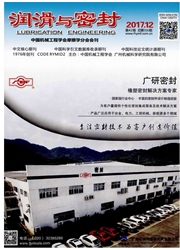

 中文摘要:
中文摘要:
基于“同一油品相同的密度对应相同的黏度”这一假说,本文作者将最近提出的在等温条件下由密度求黏度的计算公式推广到热条件之下并进行了进一步的理论探讨.通过引入广义黏度,把润滑油的Eyring流动处理为广义牛顿流动,进而对由squalane油润滑的点接触副在不同赫兹接触压力和卷吸速度下,在滑滚比宽广的变化范围内开展了定量的热弹流数值仿真.仿真得到的摩擦系数与试验结果良好的吻合程度不但证实了作者的由密度求黏度公式在热条件下仍然准确,同时也证实了所用的密度与黏度关系假说的合理性.在比较新黏度公式与Barus、Roelands和Doolittle黏度公式所得数值仿真结果时,提出了一种不需要黏温系数而得到热条件下润滑油黏度值的算法,并用之得到了合理的广义牛顿热弹流解.
 英文摘要:
英文摘要:
The new formula proposed by the authors recently for calculating the oil viscosity from the density under isothermal conditions was extended to thermal conditions based on a hypothesis of "the same density, the same viscosity for the same lubricant", and a deeper investigation was made theoretically. By introducing a concept of generalized viscosity to deal with the Eyring shear-thinning model, a number of numerical solutions of thermal elastohydrodynamic lubrication (EHL) for point contacts with squatane as lubricant under various Hertzian pressures and entraining velocities were achieved in a wide range of slide-roll ratio. It is shown that the numerical results of friction coefficient agreed well with experimental data, implying that the new viscosity-density formula was still correct under thermal conditions and the hypothesis between viscosity and density was hold reasonably. A new method to get viscosity without a viscosity-temperature coefficient was put forward when comparing the simulated results of the new viscosity formula and those of the Barus, Roelands and Doolittle formulae. Reasonable solutions were obtained with this method.
 同期刊论文项目
同期刊论文项目
 同项目期刊论文
同项目期刊论文
 Influence of surface waviness on the thermal elastohydrodynamic lubrication of an eccentric-tappet p
Influence of surface waviness on the thermal elastohydrodynamic lubrication of an eccentric-tappet p 期刊信息
期刊信息
